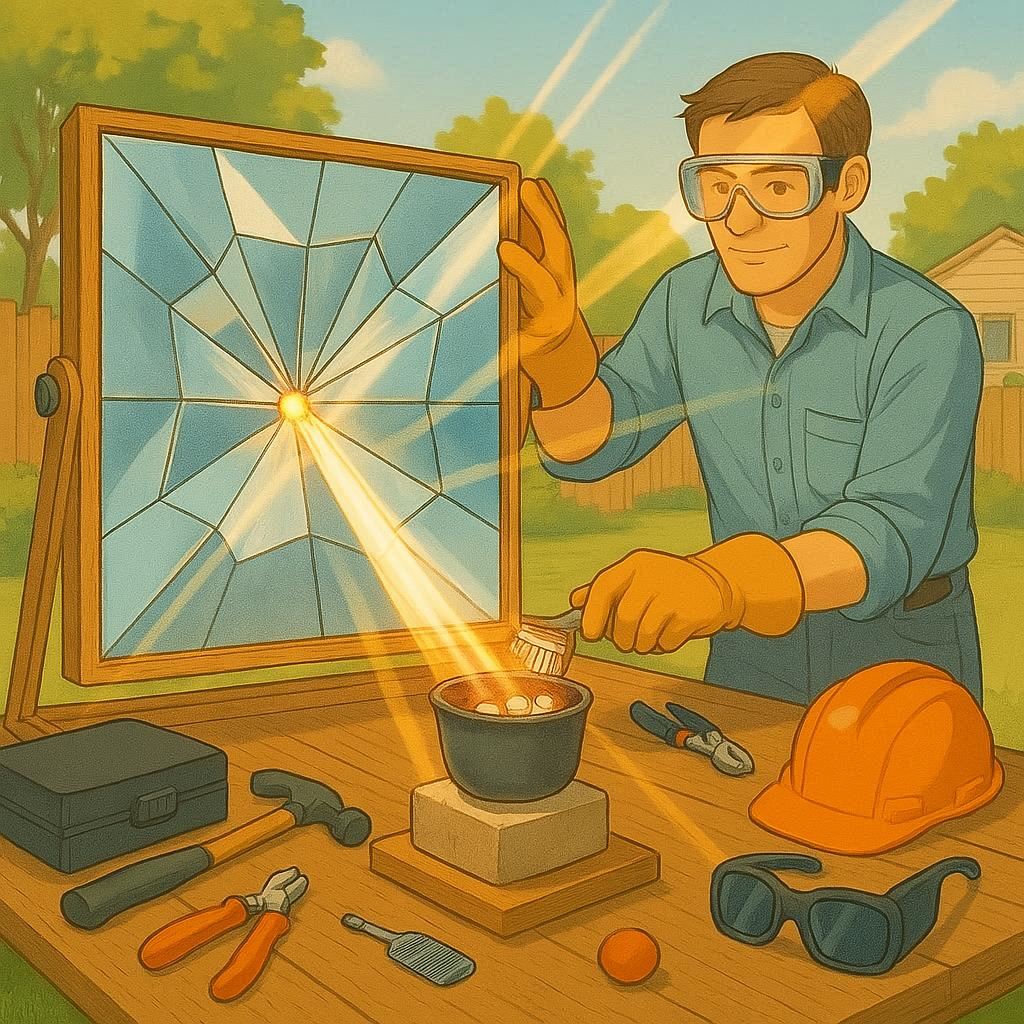Have you ever wondered how objects can be seen even when they are not directly visible? This is where the concept of reflection comes into play, and one of the most fascinating tools that utilize this principle is the periscope. A periscope is an optical instrument that allows us to see objects that are otherwise hidden from view, such as objects behind walls, around corners, or even submerged underwater. In this blog post, we’ll explore how to create a simple homemade periscope using mirrors and a few household items, while learning about the science of light reflection that makes it work. By the end of this post, you’ll have a functional periscope and a deeper understanding of how light behaves when it encounters reflective surfaces.
What is a Periscope?
Before we dive into making a homemade periscope, let’s take a moment to understand what a periscope is and how it works. A periscope is an optical instrument consisting of two mirrors or lenses that are aligned at a specific angle to allow the user to see around obstacles or into areas that would otherwise be out of view. Periscopes are commonly used in submarines, tanks, and even in medical devices to observe internal organs during surgeries.
The key to a periscope’s functionality lies in the principle of light reflection. When light hits a surface, it bounces back at an angle equal to the angle at which it hit the surface. This is known as the Law of Reflection, and it is the fundamental scientific principle that allows periscopes to work. By carefully positioning two mirrors at 45-degree angles relative to each other, a periscope ensures that light from the object is accurately reflected through the device, allowing the user to see the object clearly.
Materials Needed
Creating a homemade periscope is a fun and educational DIY project that can be completed with a few simple materials. Here’s a list of what you’ll need:
- Cardboard tube (from a paper towel roll or toilet paper roll)
- Two small, flat mirrors (square or rectangular-shaped, ideally 1 inch by 1 inch or larger)
- Scissors
- Glue or hot glue gun
- Duct tape or electrical tape
- Black paper or construction paper
- Ruler
- Pencil or marker
- Optional: paint or markers for decoration
Step-by-Step Guide
1. Measure and Cut the Tube
First, take the cardboard tube and measure its length. The length of the tube will determine the length of your periscope. For a standard periscope, a tube that’s 10-12 inches long is ideal. If your tube is longer than that, you can cut it to the desired length using scissors or a craft knife.
2. Prepare the Mirrors
Next, take the two small mirrors and ensure they are clean and free of any debris or smudges. If you’re using square or rectangular mirrors, you can leave them as they are. If you have irregularly shaped mirrors, you may need to cut them to fit inside the tube.
3. Mark the Tube
Using a ruler and a pencil, mark two circles on the ends of the cardboard tube. These marks should be slightly larger than the size of your mirrors. These circles indicate where you’ll cut out the holes for the mirrors. Additionally, mark a line down the center of the tube, running its entire length. This line will help you position the mirrors correctly.
4. Cut Out the Holes
Using scissors or a craft knife, carefully cut out the circles you marked on the ends of the tube. Make sure the holes are smooth and not jagged, as rough edges could interfere with the clarity of the image you see through the periscope.
5. Attach the Mirrors
Take one of the mirrors and apply a small amount of glue or hot glue to the back of it. Insert the mirror into one end of the tube, aligning it with the center line you drew earlier. Hold the mirror in place for a few seconds to ensure it adheres properly. Repeat this process with the second mirror, attaching it to the other end of the tube.
6. Secure the Mirrors
Once the mirrors are in place, use duct tape or electrical tape to secure them firmly to the tube. This ensures that the mirrors stay in position and won’t move around while you’re using the periscope.
7. Blacken the Inside of the Tube
To minimize light interference, it’s important to blacken the inside of the tube. Cut a strip of black paper or construction paper that’s slightly longer than the length of the tube. Roll the paper tightly and insert it into the tube, ensuring that it lines the entire inner surface. Secure the paper with a small piece of tape at the opening of the tube.
8. Test the Periscope
Now it’s time to test your homemade periscope! Look through the end of the tube where the first mirror is placed and move the periscope around to see how it works. You should be able to see objects that are outside your direct line of sight. If the image appears distorted or fuzzy, you may need to adjust the angle of the mirrors slightly.
How Does It Work?
Now that you’ve built your homemade periscope, let’s take a closer look at how it works. The periscope uses two mirrors that are placed at 45-degree angles relative to each other. When light from an object enters the periscope through the first mirror, it reflects off that mirror and then reflects off the second mirror before reaching your eye. This dual reflection allows you to see the object even if it’s hidden behind an obstacle.
The Law of Reflection, which states that the angle of incidence is equal to the angle of reflection, is crucial to the functionality of the periscope. By carefully positioning the mirrors, the periscope ensures that light from the object is accurately reflected to your eye, creating a clear and coherent image.
Learning Light Reflection Through Mirrors
One of the most valuable aspects of building a homemade periscope is the opportunity to learn about light reflection through mirrors. Light reflection is a fundamental concept in optics, and understanding it can help you grasp more complex topics such as refraction, diffraction, and even the behavior of light in lenses.
Here are some key points to consider when exploring light reflection:
1. Law of Reflection
The Law of Reflection states that the angle of incidence (the angle at which light hits a surface) is equal to the angle of reflection (the angle at which light bounces back). This law applies to all smooth, flat surfaces and is the principle upon which the periscope relies.
2. Types of Reflection
There are two main types of reflection: specular reflection and diffuse reflection. Specular reflection occurs when light hits a smooth surface, such as a mirror, and reflects off in a coherent beam. Diffuse reflection, on the other hand, occurs when light hits a rough surface, scattering in multiple directions.
3. Polished vs. Unpolished Surfaces
The type of surface that light hits plays a significant role in reflection. Polished surfaces, such as mirrors, reflect light in a coherent manner, while unpolished surfaces scatter light in various directions. This is why a mirror provides a clear reflection, while a rough surface does not.
4. Mirrors in Everyday Life
Mirrors are an integral part of our daily lives, from the mirrors in our bathrooms to the mirrors in telescopes and laser technology. Learning about light reflection through mirrors not only helps us understand how periscopes work but also opens the door to exploring more advanced applications of optics in science and technology.
The Educational Value
Building a homemade periscope is not only a fun and engaging DIY project but also a valuable educational tool. By constructing and using a periscope, you gain hands-on experience with the principles of light reflection and optics. This project is particularly useful for students studying physics or optics, as it provides a practical demonstration of how theoretical concepts work in real-world applications.
1. Hands-On Learning
Hands-on learning is one of the most effective ways to grasp complex scientific concepts. By building a periscope, you get to see the Law of Reflection in action, making it easier to understand and remember.
2. Applying Theory to Practice
This project bridges the gap between theoretical knowledge and practical application. It demonstrates how the principles of light reflection are used in real-world devices, such as periscopes, binoculars, and telescopes.
3. Encouraging Curiosity
Working on a DIY project like a homemade periscope can spark curiosity and interest in science and technology. It encourages you to ask questions, experiment with different materials, and explore the possibilities of what you can create.
## The Importance of Mirrors and Light Reflection in Technology
Mirrors and the principle of light reflection play a crucial role in many areas of technology. Understanding how mirrors work and how light interacts with them is essential for developing and improving various technologies that we use every day.
1. Periscopes
As we’ve already explored, periscopes rely on mirrors to allow users to see around obstacles. This technology is essential for military vehicles, such as submarines and tanks, where visibility is limited.
2. Telescopes and Microscopes
Both telescopes and microscopes use mirrors and lenses to magnify and focus light, enabling us to see objects that are too distant or too small to be seen with the naked eye.
3. Laser Technology
Laser technology relies heavily on mirrors and light reflection. Lasers work by bouncing light off mirrors to produce a concentrated beam of light that can travel long distances without spreading out.
### 4. Fiber Optics
Fiber optic communication relies on the principle of total internal reflection, where light is completely reflected within a medium. This technology allows for fast and reliable data transmission over long distances.
## Variations and Enhancements
Once you’ve built a basic homemade periscope, you can experiment with different variations and enhancements to improve its functionality and performance. Here are some ideas to get you started:
1. Adjusting the Angle of the Mirrors
Experiment with different angles for the mirrors to see how it affects the image you see through the periscope. The ideal angle is typically around 45 degrees, but you may find that slightly adjusting this angle improves the clarity of the image.
### 2. Adding a Focusing Mechanism
For a more advanced periscope, you can add a focusing mechanism that allows you to adjust the distance between the mirrors. This can help fine-tune the focus and improve the clarity of the image.
### 3. Using Different Types of Mirrors
Experiment with different types of mirrors, such as convex or concave mirrors, to see how they affect the image. Keep in mind that the type of mirror you use will impact the reflected image, with convex mirrors creating a smaller, wider field of view and concave mirrors producing a magnified image.
### 4. Adding a Light Source
If you plan to use the periscope in low-light environments, you can add a light source, such as an LED light, to illuminate the object you’re viewing. This can improve visibility and help you see more clearly.
### 5. Waterproofing the Periscope
For a more durable and versatile periscope, consider waterproofing it by sealing the ends with clear plastic or glass. This allows you to use the periscope underwater or in wet environments.
## Safety Tips
As with any DIY project, safety is important when building and using a homemade periscope. Here are some tips to ensure a safe and enjoyable experience:
### 1. Handle the Mirrors with Care
Mirrors can be fragile and may break if dropped. Handle the mirrors with care to avoid breakage, and ensure they are securely attached to the periscope.
### 2. Avoid Pointing the Periscope at Direct Light Sources
Never point the periscope directly at the sun or other bright light sources, as this can cause eye strain or even temporary blindness.
### 3. Use Caution in Public Places
When using the periscope in public places, use caution to avoid accidentally invading someone’s privacy or causing a distraction.
### 4. Adult Supervision
If you’re working on this project with children, adult supervision is recommended, especially when using scissors, craft knives, or hot glue guns.
## Conclusion
Building a homemade periscope is a fun and educational DIY project that offers a unique glimpse into the fascinating world of light reflection and optics. By following the simple steps outlined in this guide, you can create a functional periscope that allows you to see the world from a new and exciting perspective.
In addition to its practical applications, this project provides a valuable learning experience, helping you understand the principles of light reflection and how they are used in various technologies. Whether you’re a student, a science enthusiast, or simply someone who enjoys hands-on projects, building a homemade periscope is an engaging and rewarding activity that is sure to spark your curiosity and encourage you to explore more about the science of light.
So gather your materials, put on your thinking cap, and start building your very own homemade periscope! With a little creativity and some basic materials, you can unlock the secrets of light reflection and discover the hidden world that lies just out of sight.
I hope this blog post has inspired you to try your hand at building a homemade periscope and learning more about the fascinating science of light reflection. If you have any questions or would like to share your experience with this project, feel free to leave a comment below. Happy crafting and experimenting!



